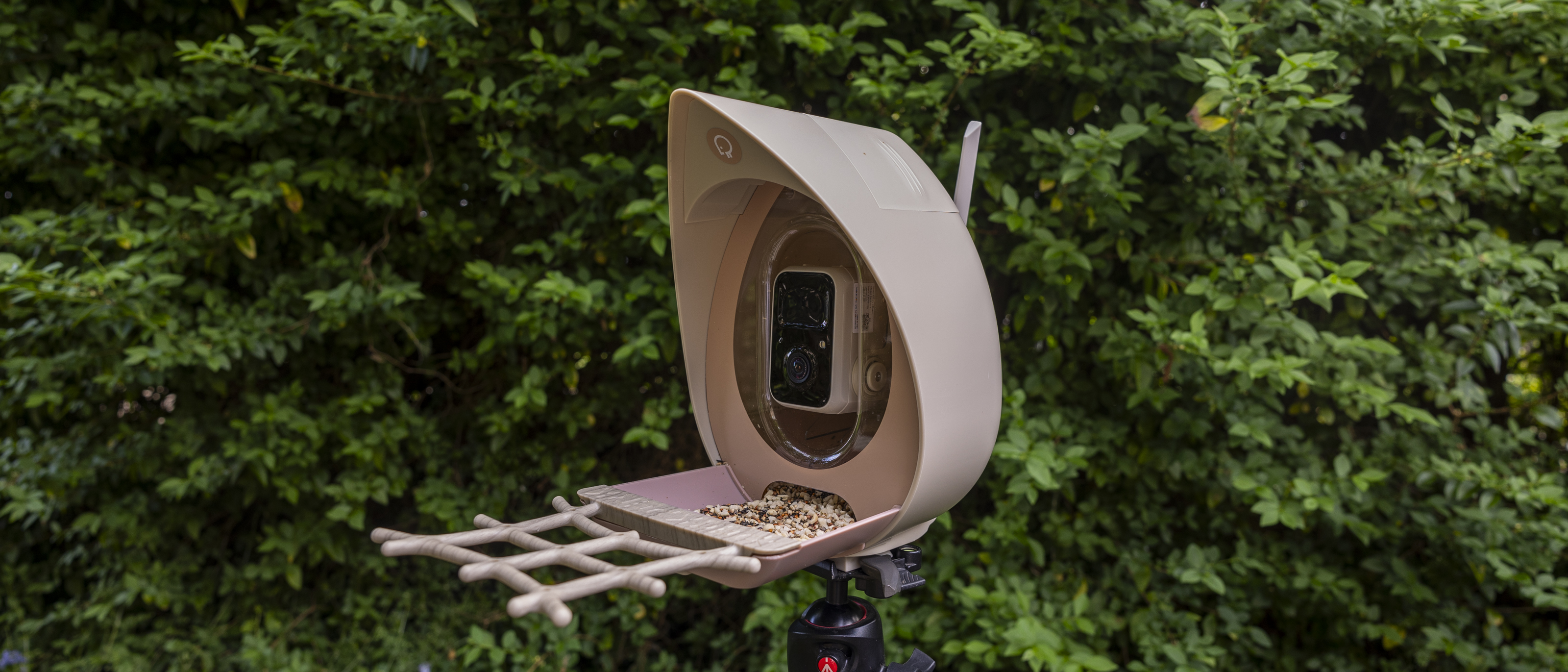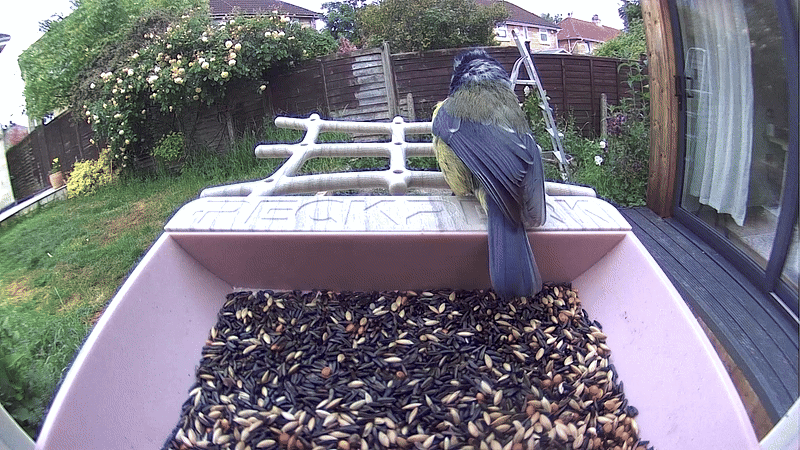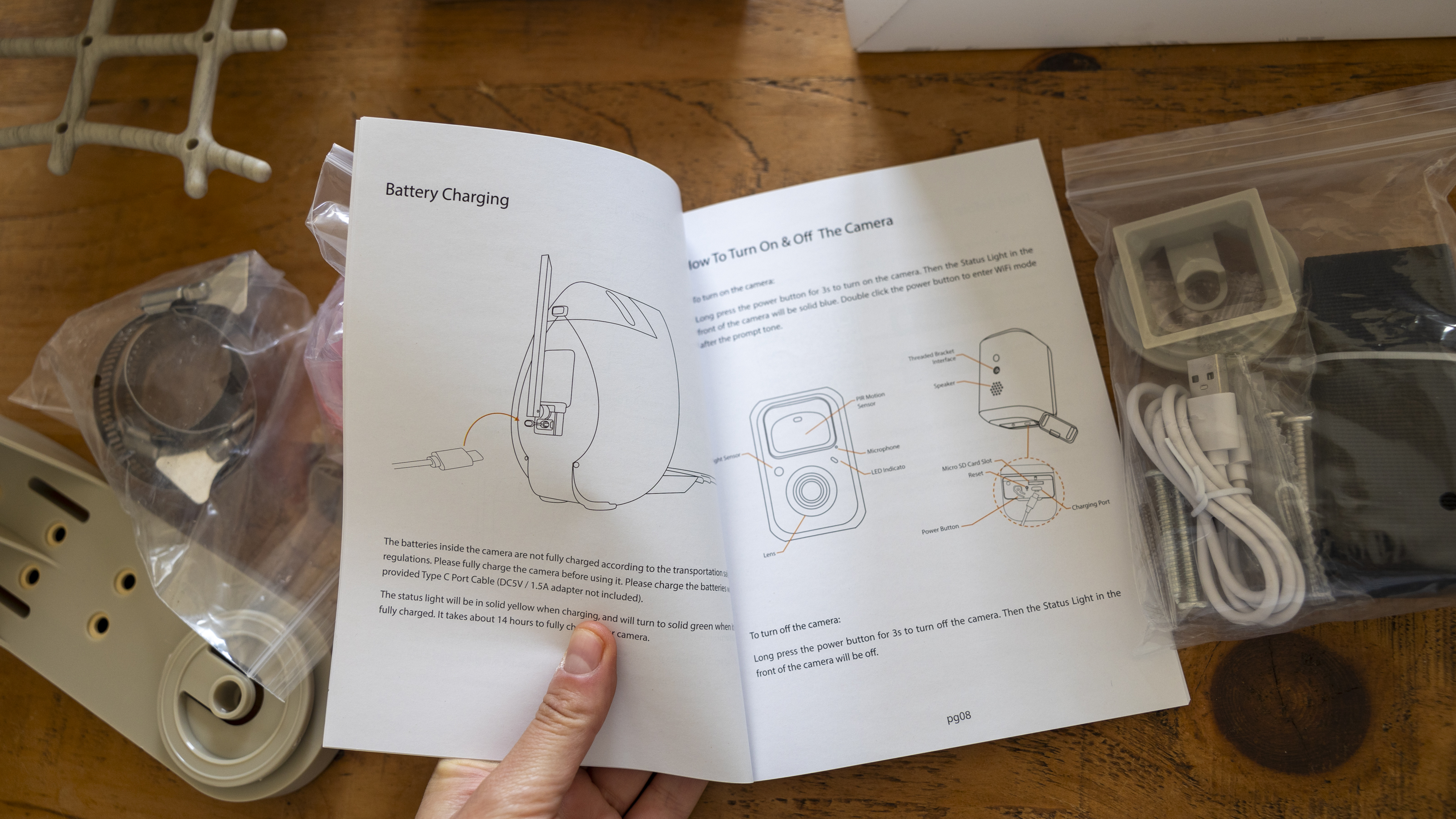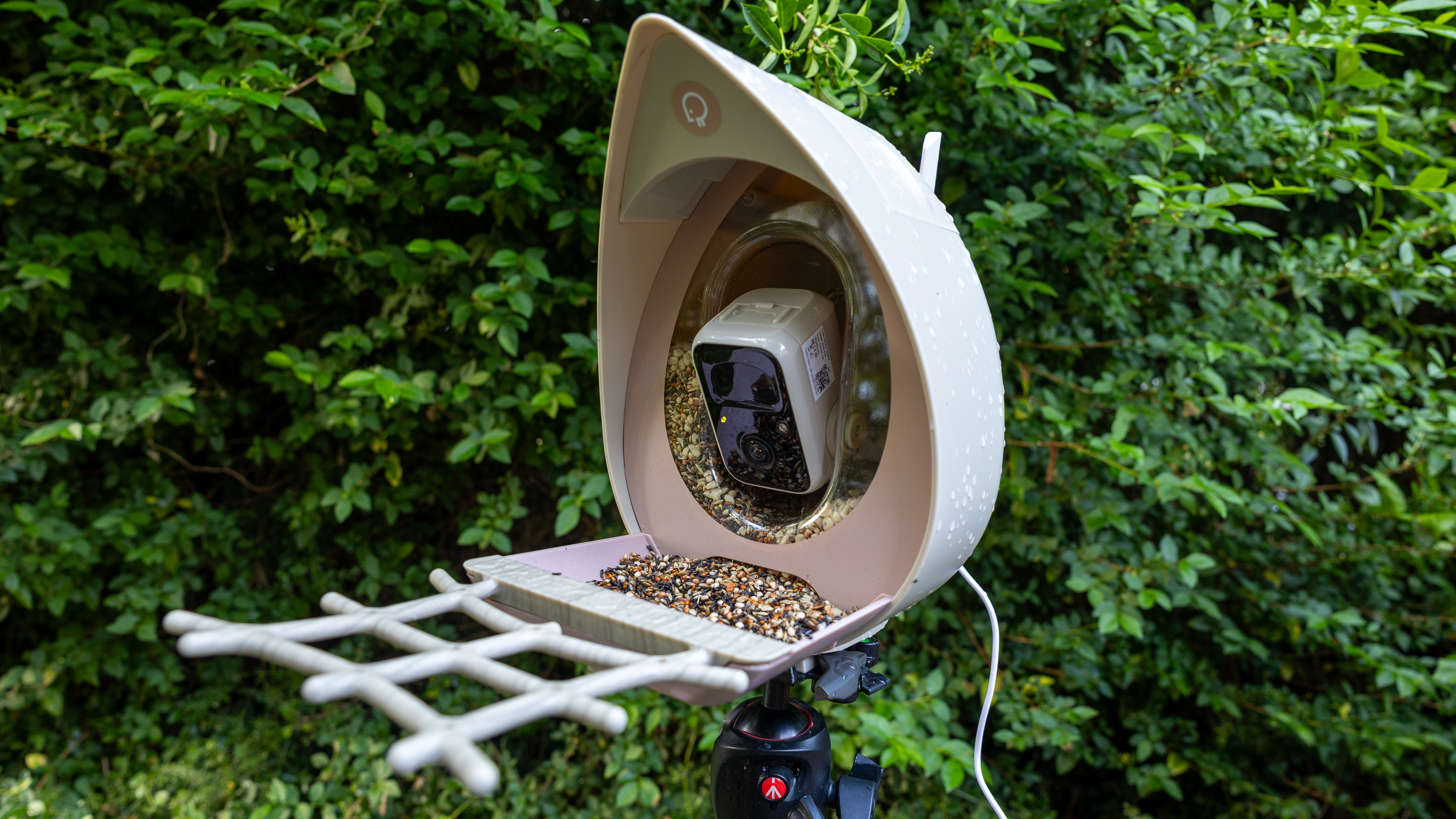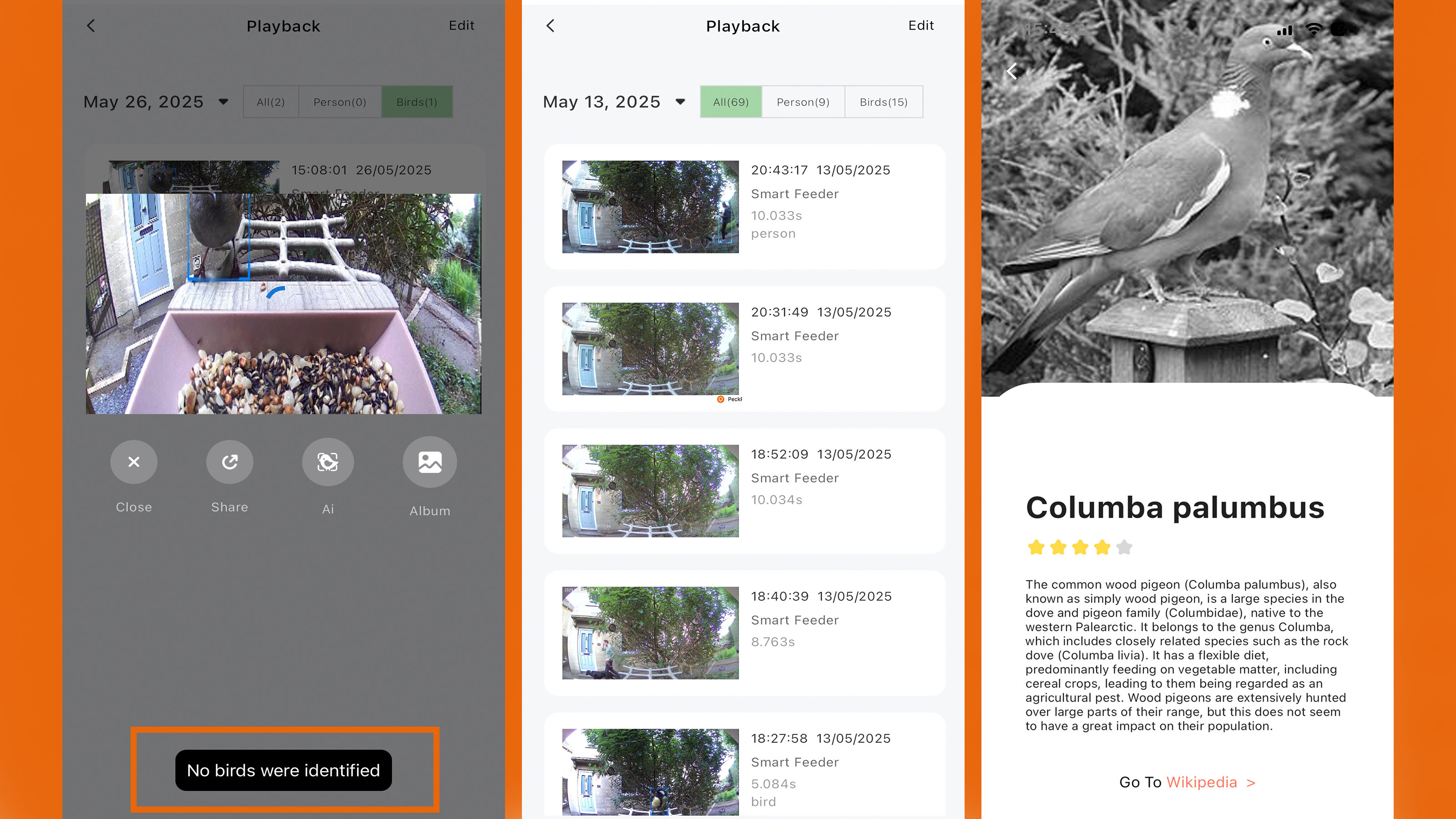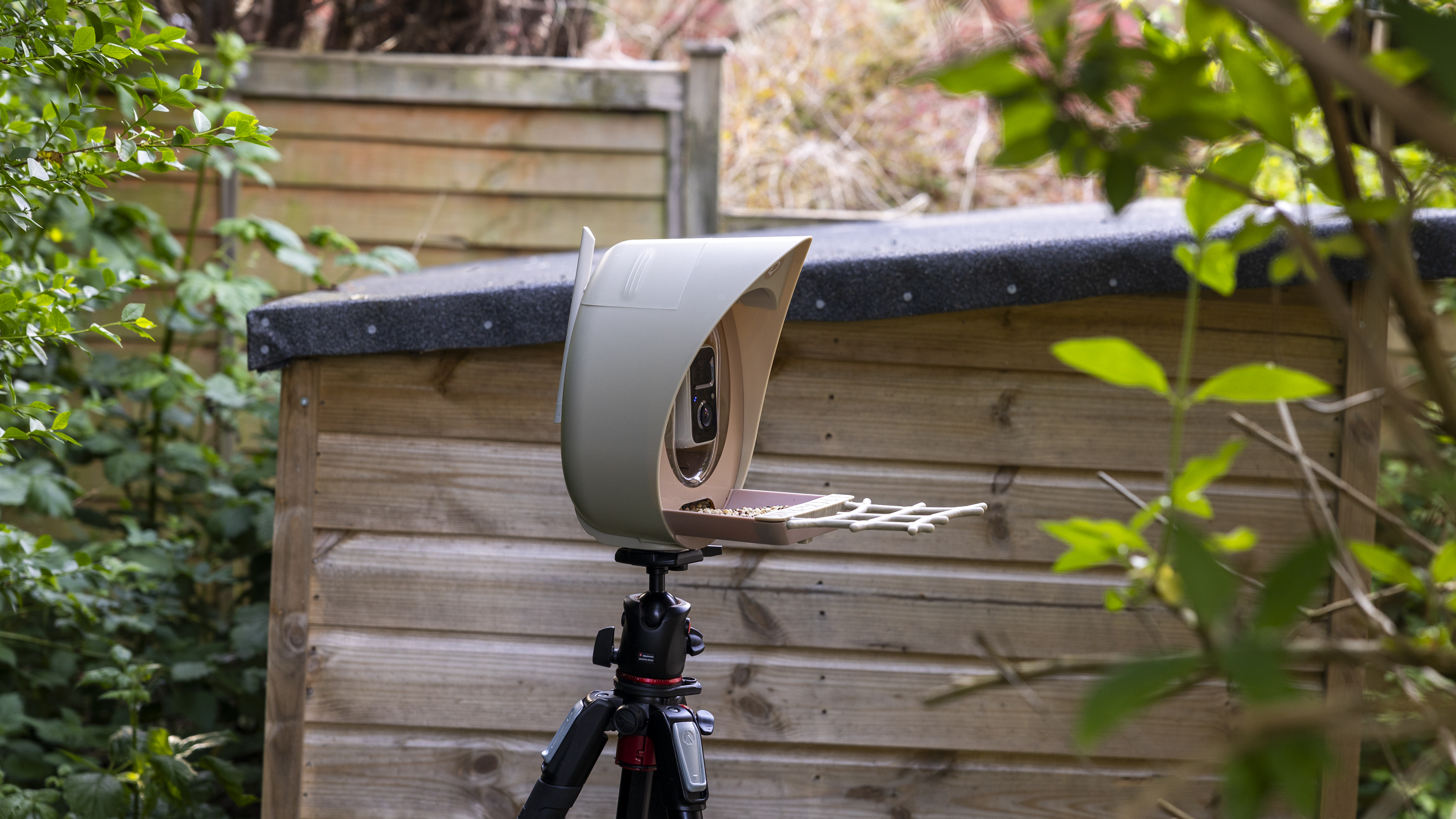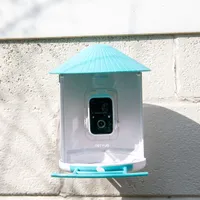Digital Camera World Verdict
The PeckPerk smart feeder is designed to bring nature closer, with a camera to capture the birds that land and AI to help you identify them. The 2K video footage is good, with enough detail to enjoy watching your feathered friends. But while the housing design is much slicker and naturalistic than many feeder cameras, the PeckPerk’s poor app interface and seemingly non-existent AI recognition mean it never delivers on its smart promise.
Pros
- +
Solar charging is convenient
- +
Easy to assemble and fill with food
- +
Subtle design and color
Cons
- -
AI identification is poor
- -
App has basic features
- -
Fiddly to mount
Why you can trust Digital Camera World
What if you could turn your garden into a private, high-definition nature reserve, identifying every feathered friend that stops by? That's the premise behind the bird feeder camera market, an area which is seemingly booming, if Amazon's clogged shopping feed of smart models is anything to go by.
Because they're so easy to use, the best bird feeder cameras can be enjoyed by casual family users as well as keen ornithologists who want to see what's in their backyard. They promise to bring nature closer, by capturing images and videos of the birds visiting and using motion detection and AI to record and identify species remotely.
I've been trying and testing bird feeder cameras for a few years now, starting with the Netvue Birdfy (one of the founding products in the category) back in 2022. And it's no wonder these fun gadgets have taken off. The world is becoming increasingly AI-integrated, and consumers are ever more data-savvy. AI bird feeders match up a curiosity of the natural world with the ability to watch it all easily via an app on a smartphone.
But with so many products already on the market, is there space for another? PeckPerk's smart bird feeder with solar panels promises a plug-and-play setup, linking to its own app where you can view the camera feed, and (if you pay a subscription) get AI bird ID and squirrel alerts.
These features aren't new or advanced, though, and PeckPerk is competing with established products in the market from the likes of Birdfy and Bird Buddy (that we rate highly). Can it win users over simply by being better-looking and easier, or cheaper to use than its rivals? I put the PeckPerk in my UK garden and used it for over a month to find out if it's a worthy way to watched winged friends.
PeckPerk bird feeder camera: Specifications
Video resolution | 2K HD (2048 x 1080) |
Field of view | 165 degrees |
Feed capacity | 1.8 liters |
Dimensions (H x W x D) | 10 x 6.3 x 7.6 in (25.3 x 16 x 19.2 cm) |
Weight | 1.45 lbs / 660 g (unfilled) |
Power | 5200 mAh rechargeable lithium-ion battery |
Power | Included USB-C cable, optional solar panels (included) |
Connectivity | 2.4 GHz WiFi, Bluetooth |
Materials | New and recycled plastics (BPA Free) |
PeckPerk bird feeder camera: Price
The PeckPerk comes in Beige or Orange, and is available more globally on the official PeckPerk website or Amazon in the US. There, the price hovers at around $159, but like most products on the e-commerce site, it fluctuates regularly with sales events.
That’s only about $20 less than the popular Netvue by Birdfy Smart Bird Feeder I reviewed several years ago – if you compare the bundles with solar panels like-for-like. Its price doesn't feel unreasonable given the PeckPerk's build quality.
The best camera deals, reviews, product advice, and unmissable photography news, direct to your inbox!
On the official PeckPerk website, the Essential model with a solar panel starts at $109/£82, a heavy cut on the RRP listed at $319/£240. If you add a Hummingbird fruit fork and a 2-year VIP subscription, the total rises to $179/£135.
I hate paying an ongoing fee for what feels like essential functionality, but (like the Netvue Bird feeder), you'll need a subscription to access PeckPerk's most useful features. If you don't buy the "VIP" service as part of a bundle upfront, it costs $3.99/£3 a month.
Being a VIP unlocks the squirrel algorithm and, more importantly, the AI-powered bird recognition system. Without VIP features, you only get real-time bird-watching and 7-day free cloud storage. On offer, the PeckPerk's price is reasonable given its build quality, and you can buy longer (but not lifetime) VIP plans to lower the monthly cost.
PeckPerk bird feeder camera: Design & Handling
The PeckPerk arrives packaged in a white cardboard box, with little indication of what's inside save for a wee orange bird and a few features listed on the side. Inside, you'll find a plethora of components – the main feeder with camera pre-attached, lid, perch, tripod adapter, USB-C power cable, solar panel, and mounting bracket – plus a surprisingly well-illustrated user guide book explaining how to put it all together.
At first glance, the PeckPerk looked like it had a lot of components to assemble. However, I had it set up and operational in under five minutes, including adjusting the camera angle and inserting a microSD card into the top slot, then downloading the app and linking the camera to my iPhone. The hardest bit was finding my WiFi password when prompted by the app walkthrough.
I want my garden to look as ‘natural’ as possible and try to avoid bright, garish additions like gnomes or fluorescent plastic cameras. Fortunately, the PeckPerk has a much more subtle design than many bird feeder cameras. It’s shaped a bit like an open almond and colored like one, too, if you buy the beige option. The plastic perch is meant to resemble the open weave of tree branches. It's not bad.
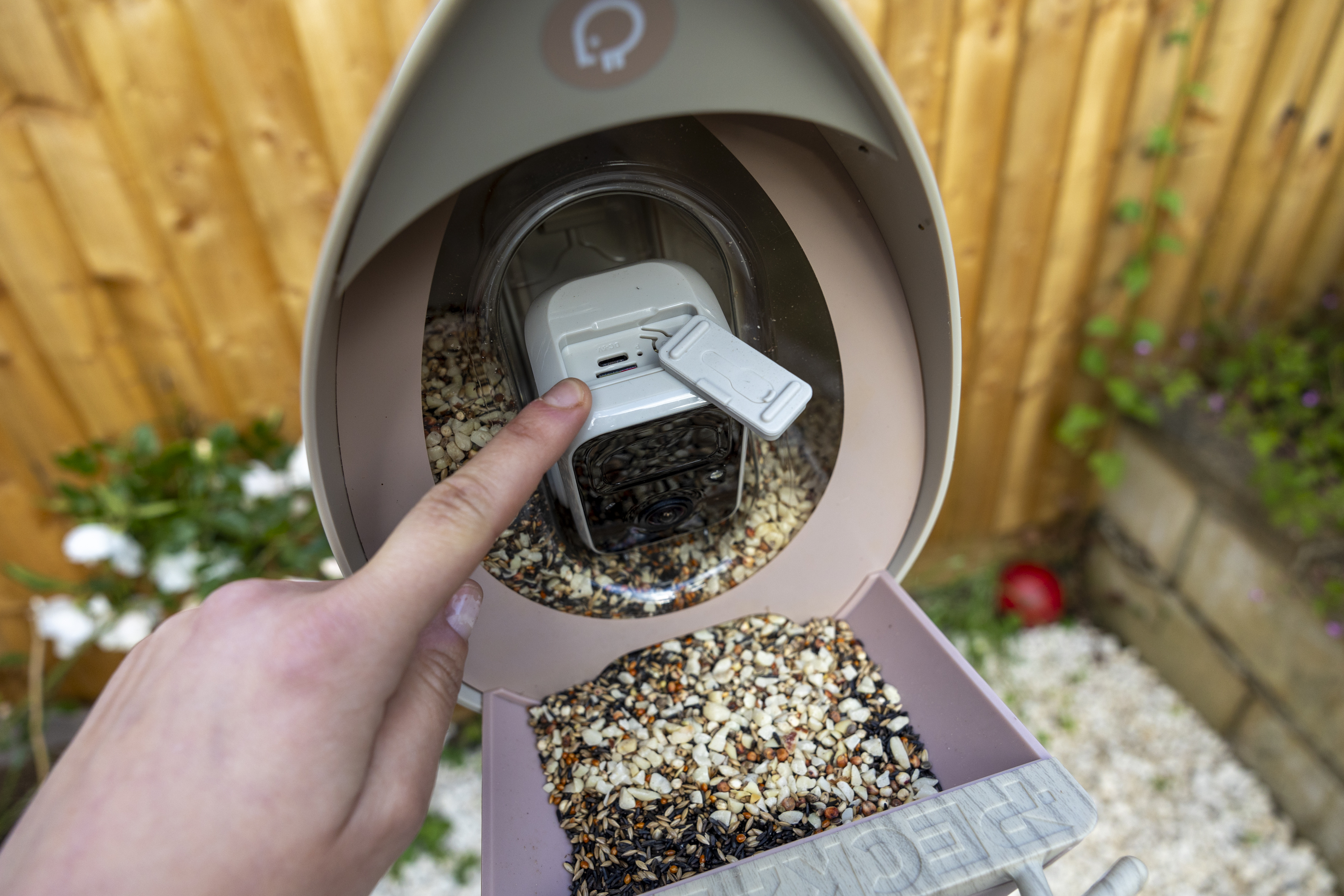

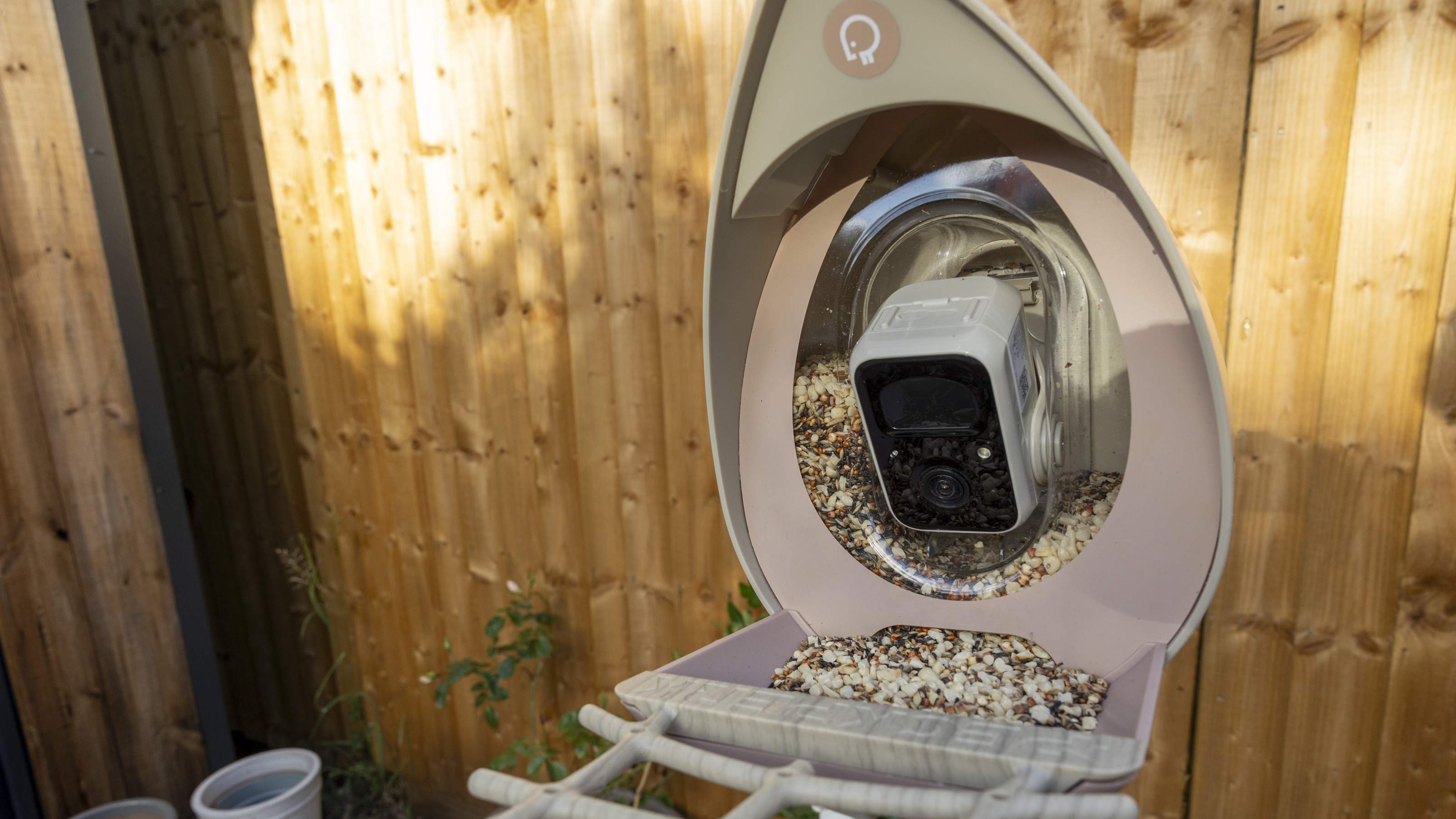
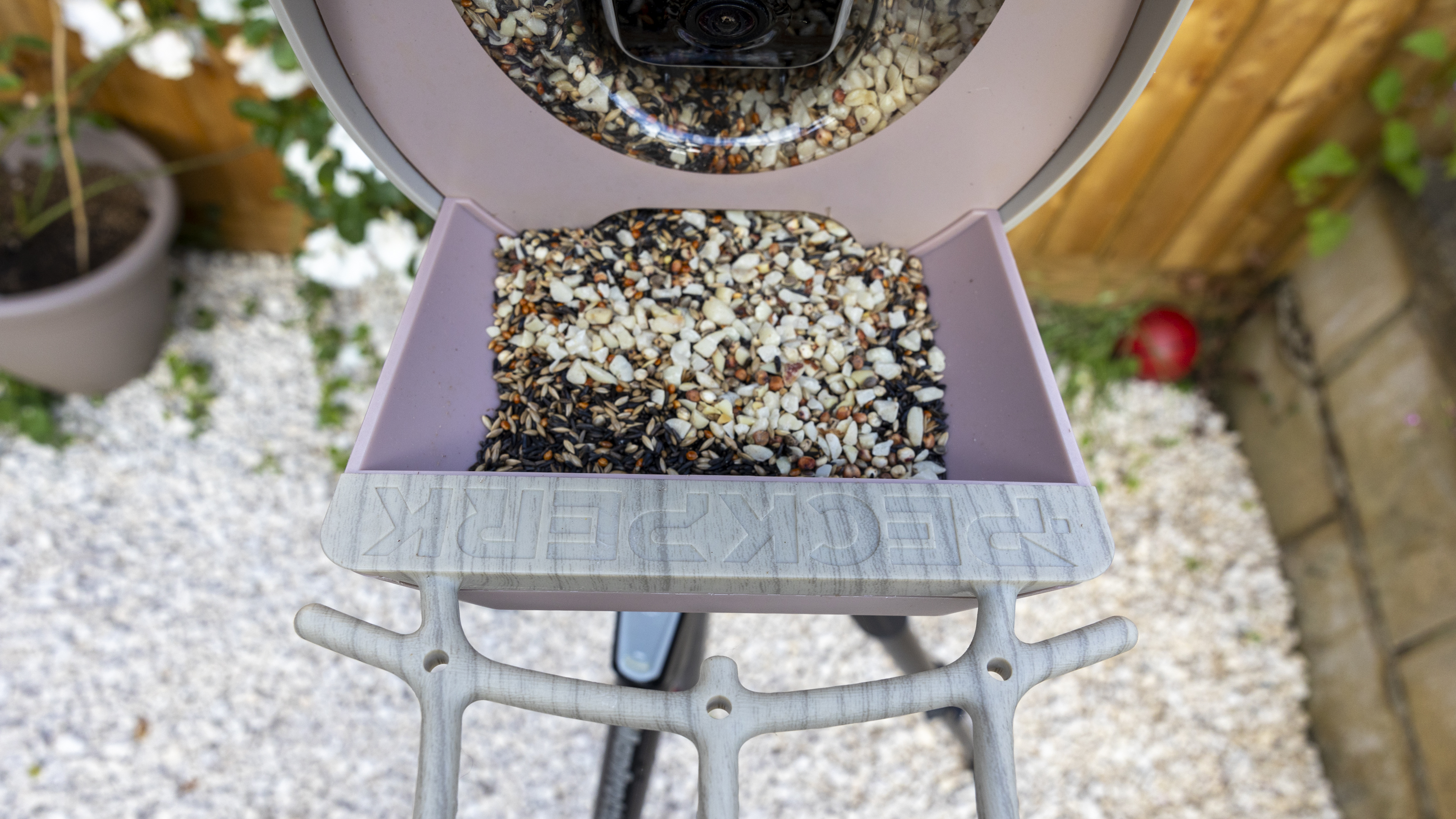
Although I mounted the camera on a tripod, the feeder would have fit right in on my sandy Cotswold stone wall using the included bracket. The design is practical too, with screws to firmly secure the perch and lid, and silicone covers that protect the charging port and the memory card slot from moisture.
Like all cameras designed to live outside permanently, the PeckPerk feeder is made from plastic, and its IP65 rating means it's resistant to wind and rain but not totally waterproof. Thought has also been given to wet weather clogging up the bird food, and there’s a hole in the bottom of the seed container to allow drainage. This works well, and one morning after a night of heavy rain, I went to refill the feeder and noticed steady dripping from the base.
I prefer to only semi-fill my bird feeders and top up as and when needed to keep the food fresher. Especially as it can take birds a while to get used to new feeders. That said, you can pour a lot of bird food in the PeckPerk’s 1.8-liter capacity container, larger than the maximum 1.5 liters of many popular alternatives. And that’s handy if the feeder is somewhere harder to reach, not near your house, or you just don’t want to be refilling it as often.
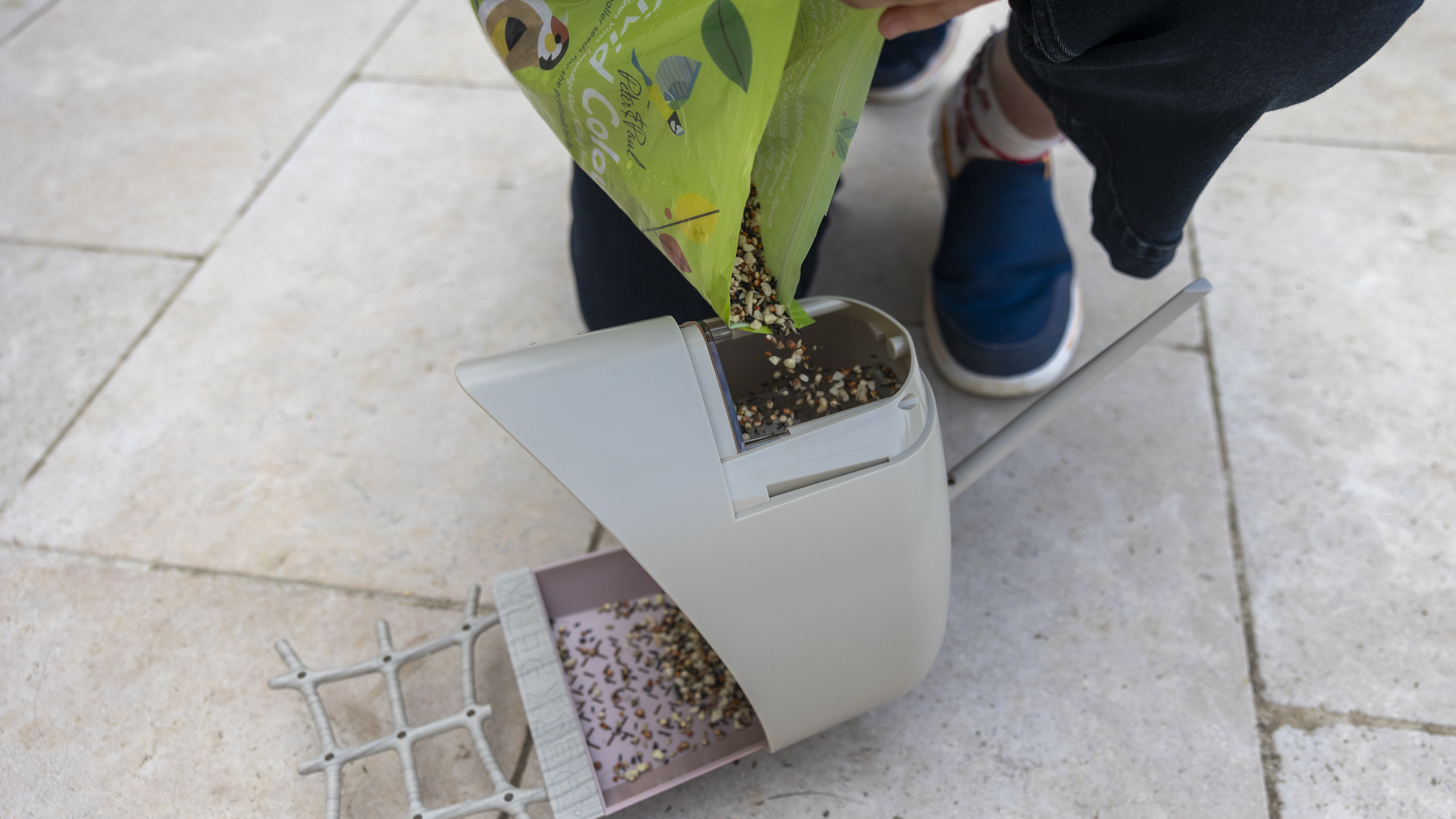
The last step was deciding where to put the PeckPerk, so that it had a strong 2.4GHz Wi-Fi signal, enough direct sunlight for the solar panel to charge, and was stable when filled with food. There are options for pole, tree, wall and tripod mounting, which theoretically gives you flexibility in choosing the most suitable spot.
Sadly for me, the hose clips weren't big enough for even the smallest drain pipe in my front garden, while the tree strap was too big. I accept that's more of a personal problem, but in the end, I had to use a sturdy tripod usually reserved for landscape photography and leave it in the garden – not something I'd be inclined to do long-term. Fortunately, as the feeder is relatively light at 1.45 lbs (660 g), there was no wobble once on the tripod.
The solar panel was a doddle to add, too. Unlike the Bird Buddy, which has a solar roof as an optional accessory to keep the camera battery topped, the loose panel simply plugs into the power slot at the back of the camera. Rather than faff about mounting it, I just rested it on my bike shed for easy removal once it had topped up.
PeckPerk bird feeder camera: Performance
Above: Sample clips from the PeckPerk camera
The footage that PeckPark captures is detailed enough to see the bird's feathers in bright sunlight. And while the bird's colors are muted on cloudier days, they're certainly more vivid and exciting under blue skies. The microphone records clear bird song when subjects are very close to the camera, but noises become understandably muffled as they shuffle around the perch.
On one very wet day, I noticed that the camera had fogged up, making the visitors harder to see, and that's something to bear in mind when you position the camera, should you need to go and wipe it dry.
Although the video clips are good enough to share on social media (or WhatsApp to my wildlife-nutty family), the downloaded videos looked pixelated at times, likely due to buffering issues over the wireless connection. I have superfast broadband, and the feeder was less than a few meters from my router (admittedly through a window). It's worth noting that the PeckPerk isn't alone with this, as the same problem was found when the Bird Buddy was tested.
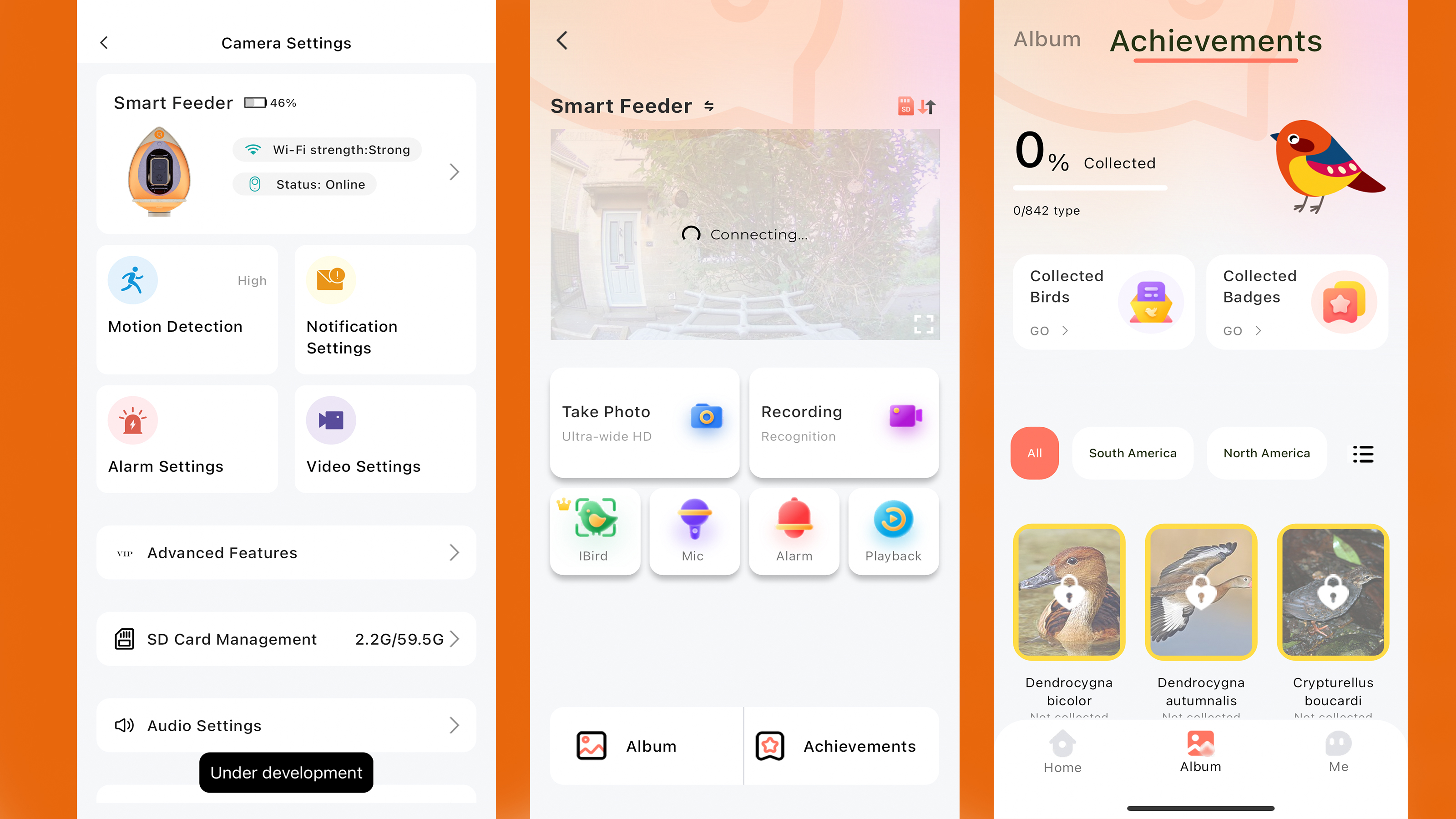
The strength of any AI bird feeder is really in its app. After all, if it's a pain to watch and organise your clips, and to find out the identity of the birds in your garden, then why not just have a standard, cheaper bird feeder camera with a microSD you take out and offload every so often?
While the PeckPerk does have a useful microSD card slot for footage spillover, it also stores up to 3GB of data on a rolling basis. There are three main ways to view footage on the app: by live streaming, from the playback section where automatically recorded clips are stored, or the album section (which contains clips you’ve saved from the playback section or recorded manually on the app yourself).
It’s a slightly clunky system, and it took me a while to figure out where the recordings were going. In the playback section, clips are organised by date, and you can filter by all, person or birds to whittle down the number. I admit that the PeckPerk AI detection was good at detecting me heading out on my daily dog walks and delivery drivers appearing at the front door.
Maybe I've been spoiled by modern technology, but I found the app to be slow and unintuitive. Loading the live connection sometimes took up to ten seconds, by which point most birds had flown off, so it's not brilliant if you want to watch the birds in real time after being pinged to their presence.
Now onto the dealbreaker. I signed up for a month of the PeckPerk VIP upgrade, which is supposed to give you AI recognition of over 11,000 bird species. The bonus here is that once you've spotted and identified a bird in your garden, you can "collect it" as an achievement and start to build a picture of all the species coming to feed over time.
In theory, this should be both useful and great fun. But in the month that I tested the PeckPerk, it didn't once identify a bird or squirrel, despite seeing very common species like pigeons, Eurasian bluetits and a European robin.
The birds listed in the Achievements section of the app are also US-centric, listing South and North America only, but even then, there aren't 11,000 in the list. When I asked Google, "How many bird species are there in the world?" it told me that there are roughly 11,000, which is a convenient match for PeckPerk's product promises.
It feels like the brand has work to do on improving its AI-identifying algorithm, or in updating its app (or both), because in its current state, it feels like the paid-for feature is utterly false advertising.
I struggle to enjoy or recommend a product when it doesn't fulfil its core promise, and I'd be very annoyed if I had bought the product myself rather than being sent a review sample. I also put in a product support request on the app, but haven't yet had a reply.
I hate to leave a review on such a sour note, so I'll add that the PeckPerk's battery life was impressive, providing over two weeks of power while constantly on. Once the neat solar panel was plugged in, of course, that meant constant battery life and no need to bring the housing in again for fresh power.
PeckPerk bird feeder camera: Verdict
Overall, the PeckPerk was frustrating to use. Good points include the video footage quality, which was great at capturing detail for feathered friends in bright light. In low light, the results are a little more muddy, but then at night, the infrared kicks in again for results much better than most wildlife trail cameras.
PeckPerk promises that its feeder offers an "intuitive app, AI bird ID, and auto squirrel alerts", but none of these features worked reliably or smoothly. The feeder wasn't able to identify one of the 10+ garden bird species in my UK location. Nor did it pulse an alarm to ward off the squirrels, even after capturing a hungry creature at least 20 times on the feeder.
Despite being well-designed, attractive and easy to fill and clean, what lets the PeckPerk down completely is its smart tech. The product never quite lived up to its promise, and it doesn't offer anything new over rivals like the Netvue Birdfy or Bird Buddy, despite being at a similar price. For almost all types of users, there are simply smarter, more reliable bird feeder cameras out there.
Features | The bird ID and squirrel alarms are unreliable, and the app is basic. | ★★☆☆☆ |
Design | Nice-looking physical housing, let down by a clunky app interface. | ★★★☆☆ |
Performance | AI recognition didn't pick up any birds, but the video quality is good enough to ID them yourself. | ★★★☆☆ |
Value | Neither premium or cheap, there are better options for the money. | ★★★☆☆ |
Should you buy the PeckPerk bird feeder camera?
✅ Buy this if...
- You want something that looks more subtle and natural than most feeders
- You want to deter squirrels. The alarm doesn't work reliably or scare visitors
🚫 Don't buy this if...
- You want real-time recognition, as the AI identification is terrible
- You're on a tight budget. There are better feeders under $100/£100
Alternatives
Netvue Birdfy smart camera
This was the first bird feeder cam I ever tested, and it's stood the test of time. If cost is a factor, it's more expensive than PeckPerk, but it gives you 30 days of free storage (instead of 7) and a more refined app. It's a brighter and bolder option, but the camera is the same.
Technaxx bird feeder camera station
The rugged Technaxx is one of the more affordable bird feeder cameras, but lacks species recognition and uses AA battery power rather than being rechargeable. With a hangable, camouflaged design, it's best for you if you want a subtle, cheaper option without AI.

Lauren is a writer, reviewer, and photographer with ten years of experience in the camera industry. She's the former Managing Editor of Digital Camera World, and previously served as Editor of Digital Photographer magazine, Technique editor for PhotoPlus: The Canon Magazine, and Deputy Editor of our sister publication, Digital Camera Magazine. An experienced journalist and freelance photographer, Lauren also has bylines at Tech Radar, Space.com, Canon Europe, PCGamesN, T3, Stuff, and British Airways' in-flight magazine. When she's not testing gear for DCW, she's probably in the kitchen testing yet another new curry recipe or walking in the Cotswolds with her Flat-coated Retriever.
You must confirm your public display name before commenting
Please logout and then login again, you will then be prompted to enter your display name.
